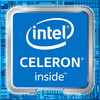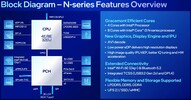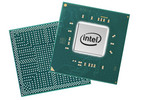Intel Celeron J4105 vs Intel Core i3-N305 vs Intel Celeron N4100
Intel Celeron J4105
► remove from comparison
The Intel Celeron J4105 is a quad-core desktop SoC primarily for mini PCs and mini ITX mainboards. It runs at 1.5 - 2.5 GHz (Single Core Burst) and is based on the Gemini Lake platform. Similar to the Apollo Lake predecessor, the chip is manufactured in a 14 nm process with FinFETs but offers slightly improved processor cores, double the amount of L2 cache, a smaller package, a new generation of monitor outputs (Gen 10) and a partly integrated WiFi chip. Besides four CPU cores, the chip also includes a DirectX 12 capable GPU as well as a DDR4/LPDDR4 memory controller (dual-channel, up to 2400 MHz). The SoC is not replaceable as it is directly soldered to the mainboard.
Architecture
The processor architecture was slightly reworked and is now called Goldmont Plus. It features an increased level 2 cache (to 4 MB). That means the per-clock-performance should be a bit better, but not near the Core CPUs like Kaby Lake Y.
Performance
While we have not tested a single system built around the J4105 as of August 2023, we have tested a certain number of laptops featuring the Celeron N4120, a chip with very similar specs (4 cores, 4 threads, up to 2.6 GHz). Based on that, expect the J4105 to be very slow in all but the most basic activities.
Intel Core i3-N305
► remove from comparison
The Intel Core i3-N305 is an entry-level mobile CPU for thin and light laptops from the Alder Lake-N series. It was announced in early 2023 and offers no performance cores and 8 efficient cores (E-cores, Gracemont architecture). The chip does not support HyperThreading and clocks with up to 3.8 GHz. The performance of the E-cores should be similar to old Skylake cores (compare to the Core i7-6700HQ). All cores can use up to 6 MB L3-cache.
Performance
We have not tested a single system built around the N305, as of September 2023. Expect the chip to be 50% to 100% faster than the N95 (4 cores, 4 threads, up to 3.4 GHz).
Your mileage may vary depending on how high the CPU power limits are and how competent the cooling solutuion of your system is.
Features
The Alder Lake-N chips only support single channel memory with up to DDR5-4800, DDR4-3200 or LPDDR5-4800. The chip also supports Quick Sync and AV1 decoding (most likely same engine as in Alder Lake). Furthermore, Wi-Fi 6E and Bluetooth 5.2 are partly integrated (but no Thunderbolt). External chips can be connected via PCIe Gen3 x9 (via the PCH).
The integrated graphics adapter is based on the Xe-architecture and offersall 32 EUs (Execution Units) operating at up to 1.25 GHz. In addition to the single channel memory, the gaming performance is very limited of the iGPU.
Power consumption
The i3 has a base power consumption of 15 W and can be configured down to 9 W. The CPU is built with a further improved 10nm SuperFin process at Intel (called Intel 7).
Intel Celeron N4100
► remove from comparison
The Intel Celeron N4100 is a quad-core SoC primarily for inexpensive notebooks and was announced late 2017. It runs at 1.1-2.4 GHz (Single Core Burst, Multi Core Burst max 2.3 GHz) and is based on the Gemini Lake platform. Similar to the Apollo Lake predecessor, the chip is manufactured on a 14 nm process with FinFETs but offers slightly improved processor cores, double the amount of L2 cache, a smaller package, a new generation of monitor outputs (Gen 10) and a partly integrated WiFi chip. Besides four CPU cores, the chip also includes a DirectX 12 capable GPU as well as a DDR4/LPDDR4 memory controller (dual-channel, up to 2400 MHz). The SoC is not replaceable as it is permanently soldered to the mainboard.
Architecture
The processor architecture was slightly reworked and is now called Goldmont Plus. It features an increased Level 2 cache (to 4 MB). That means the per-clock-performance should be a bit better, but not near the Core CPUs like Kaby Lake Y.
Performance
The average N4100 in our database directly competes with AMD's 3020e and 3050e, as far as multi-thread benchmark scores are concerned. The Intel Core m3-8100Y and the Celeron 6305 are close nearby as well. Routinely described as "entry-level" in 2019 and 2020, the Celeron N4100 is a slow processor that is good for the most basic tasks only such as Web browsing with no more than two or three tabs open at a time.
The LapBook Pro is among the fastest systems built around the N4100 that we know of. It can be around 50% faster in CPU-bound workloads than the slowest system featuring the same chip in our database, as of August 2023.
Graphics
The UHD Graphics 600 (Gemini Lake) is based on Intel's Gen9 architecture, which supports DirectX 12 and is also used for the Kaby Lake / Skylake / Apollo Lake graphics adapters (like HD Graphics 520). Equipped with 12 EUs and a clock of up to 700 MHz, the performance should be roughly on par with the older HD Graphics 500 (Apollo Lake).
The chip also includes an advanced video engine with hardware support for the playback of VP9 and H.265 material (8-bit color-depth).
Power Consumption
Celeron N4100 has a default TDP of 6 W (also known as PL1), making it a great option for passively cooled setups.
The fairly old 14 nm process this Celeron is built with makes for so-so, as of mid-2022, energy efficiency.
| Model | Intel Celeron J4105 | Intel Core i3-N305 | Intel Celeron N4100 | ||||||||||||||||||||||||||||||||||||||||||||||||||||||||||||||||||||||||||||
| Codename | Gemini Lake | Alder Lake-N | Gemini Lake | ||||||||||||||||||||||||||||||||||||||||||||||||||||||||||||||||||||||||||||
| Series | Intel Gemini Lake | Intel Alder Lake-N | Intel Gemini Lake | ||||||||||||||||||||||||||||||||||||||||||||||||||||||||||||||||||||||||||||
| Series: Gemini Lake Gemini Lake |
|
|
| ||||||||||||||||||||||||||||||||||||||||||||||||||||||||||||||||||||||||||||
| Clock | 1500 - 2500 MHz | 1800 - 3800 MHz | 1100 - 2400 MHz | ||||||||||||||||||||||||||||||||||||||||||||||||||||||||||||||||||||||||||||
| L2 Cache | 4 MB | 4 MB | 4 MB | ||||||||||||||||||||||||||||||||||||||||||||||||||||||||||||||||||||||||||||
| Cores / Threads | 4 / 4 | 8 / 8 8 x 3.8 GHz Intel Gracemont E-Core | 4 / 4 | ||||||||||||||||||||||||||||||||||||||||||||||||||||||||||||||||||||||||||||
| TDP | 10 Watt | 15 Watt | 6 Watt | ||||||||||||||||||||||||||||||||||||||||||||||||||||||||||||||||||||||||||||
| Technology | 14 nm | 10 nm | 14 nm | ||||||||||||||||||||||||||||||||||||||||||||||||||||||||||||||||||||||||||||
| max. Temp. | 105 °C | 105 °C | 105 °C | ||||||||||||||||||||||||||||||||||||||||||||||||||||||||||||||||||||||||||||
| Socket | BGA1090 | BGA1264 | BGA1090 | ||||||||||||||||||||||||||||||||||||||||||||||||||||||||||||||||||||||||||||
| Features | DDR4-2400/LPDDR4-2400 RAM, PCIe 2, MMX, SSE, SSE2, SSE3, SSSE3, SSE4.1, SSE4.2, VMX, SMEP, SMAP, MPX, EIST, TM1, TM2, Turbo, AES-NI, RDRAND, RDSEED, SHA, SGX | DDR4-3200/DDR5-4800/LPDDR5-4800 RAM (sin. chan.), PCIe 3, GNA, MMX, SSE, SSE2, SSE3, SSSE3, SSE4.1, SSE4.2, AVX, AVX2, BMI2, ABM, FMA, ADX, VMX, SMEP, SMAP, EIST, TM1, TM2, Turbo, SST, AES-NI, RDRAND, RDSEED, SHA | DDR4-2400/LPDDR4-2400 RAM, PCIe 2, MMX, SSE, SSE2, SSE3, SSSE3, SSE4.1, SSE4.2, VMX, SMEP, SMAP, MPX, EIST, TM1, TM2, Turbo, AES-NI, RDRAND, RDSEED, SHA, SGX | ||||||||||||||||||||||||||||||||||||||||||||||||||||||||||||||||||||||||||||
| iGPU | Intel UHD Graphics 600 (250 - 750 MHz) | Intel UHD Graphics 32EUs (Alder Lake) (1000 - 1250 MHz) | Intel UHD Graphics 600 (200 - 700 MHz) | ||||||||||||||||||||||||||||||||||||||||||||||||||||||||||||||||||||||||||||
| Architecture | x86 | x86 | x86 | ||||||||||||||||||||||||||||||||||||||||||||||||||||||||||||||||||||||||||||
| $107 U.S. | $107 U.S. | ||||||||||||||||||||||||||||||||||||||||||||||||||||||||||||||||||||||||||||||
| Announced | |||||||||||||||||||||||||||||||||||||||||||||||||||||||||||||||||||||||||||||||
| Manufacturer | ark.intel.com | ark.intel.com | ark.intel.com | ||||||||||||||||||||||||||||||||||||||||||||||||||||||||||||||||||||||||||||
| L1 Cache | 768 KB | ||||||||||||||||||||||||||||||||||||||||||||||||||||||||||||||||||||||||||||||
| L3 Cache | 6 MB |
Benchmarks
Average Benchmarks Intel Celeron J4105 → 100% n=2
Average Benchmarks Intel Core i3-N305 → 266% n=2
Average Benchmarks Intel Celeron N4100 → 84% n=2
* Smaller numbers mean a higher performance
1 This benchmark is not used for the average calculation













